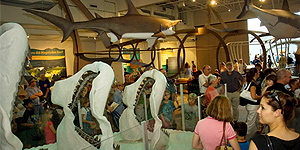By Bruce MacFadden
Every semester the PCP-PIRE sponsors at least one organized course focused on the themes, goals, and deliverables of the project. During the Fall 2011 semester, I will lead a three-credit graduate seminar on developing natural history exhibits. This will start us towards our ultimate goal to have a PCP-PIRE exhibit available for display at venues in 2014, coinciding with the centennial of the Panama Canal.

During the Fall 2011 seminar we will study theory, best practices and innovation with natural history exhibits. It will be taught by video-teleconferencing so that students at UF and those living in Panama will together have real-time access and engagement. Students will also engage in a group class project related to the initial phases of the PCP-PIRE exhibit development. The seminar will include guest instructors from the museum professional and STEM community.
During subsequent semesters, PCP-PIRE students will have the opportunity to continue participation with this exhibit via other PCP-PIRE seminars, funded internship experiences or as a non-traditional thesis Broader Impact deliverable. As with all aspects of the PCP-PIRE, student engagement is a priority, and the multi-year development of the exhibit is no exception. We are excited to begin the process of PCP-PIRE exhibit development during the Fall 2011 seminar.
Por Bruce MacFadden
Cada semestre, el PCP-PIRE patrocina al menos un curso enfocado en los temas, objetivos y resultados tangibles del proyecto. Durante el otoño del 2011, lideraré un seminario de posgrado de tres créditos acerca del desarrollo de exhibiciones de historia natural. Con este seminario, empezaremos a avanzar hacia nuestro objetivo final de tener una exhibición del PCP-PIRE en el 2014, coincidiendo con el centenario del Canal de Panamá.

Durante el seminario estudiaremos teoría, mejores prácticas e innovación en exhibiciones de historia natural. El curso se realizará a través de video conferencia de modo que los estudiantes en la Universidad de la Florida y aquellos viviendo en Panamá, podrán encontrarse y tener acceso en tiempo real. Los estudiantes también participarán en proyectos de clase grupales relacionados con las fases iniciales del desarrollo de la exhibición del PCP-PIRE. El seminario incluirá instructores invitados del museo y de otras áreas de la ciencia (STEM).
Durante los semestres siguientes, los estudiantes del tendrán la oportunidad de participar en esta exhibición ya sea a través de otros seminarios del PCP-PIRE, pasantías financiadas o como resultado de una tesis no-tradicional. Así como en todos los aspectos del PCP-PIRE, el compromiso de los estudiantes es una prioridad y el desarrollo de una exhibición durante varios años, no es la excepción. Estamos emocionados de empezar el desarrollo de esta exhibición del PCP-PIRE durante este seminario.